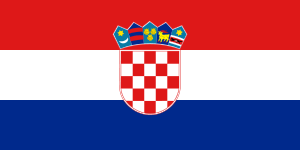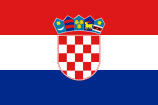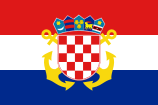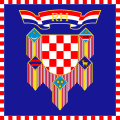- Flag of Croatia
-
Flag of Croatia
Use National flag 
Proportion 1:2 Adopted December 21, 1990 Design A horizontal tricolor of red, white, and blue with the Coat of Arms of Croatia in the center. 
Variant flag of Croatia Use Civil and state ensign 
Proportion 2:3 Adopted 1992 Design Three equal horizontal bands of red (top), white, and blue superimposed by the Croatian coat of arms. 
Variant flag of Croatia Use Naval ensign 
Proportion 2:3 Adopted 1992 Design Three equal horizontal bands of red (top), white, and blue superimposed by the emblem of the Croatian Navy. The flag of Croatia is one of the state symbols of Croatia. It consists of three equal size, horizontal stripes in colours red, white and blue. The flag combines the colours of the flags of the Kingdom of Croatia (red and white), the Kingdom of Slavonia (white and blue) and the Kingdom of Dalmatia (red and blue). Those three kingdoms are the historic constituent states of the Croatian Kingdom. In the middle is the Coat of Arms of Croatia.
The red-white-blue tricolour has been used as the Croatian flag since 1848. While the Banovina of Croatia existed within the Kingdom of Yugoslavia, it had a similar flag without the modern crown above the chequy. During the Independent State of Croatia, flag was like the modern, but without crown and there was letter "U" at the top left of the flag. Also, first field of Croatian chequy was white. While Croatia was part of SFR Yugoslavia its tricolour was the same, but it had a five-pointed red star with a yellow border in place of the coat of arms. The star was replaced by the coat in May 1990, shortly after the first multi-party elections. The current flag and the coat of arms were officially adopted on 21 December 1990, about ten months before the proclamation of independence from Yugoslavia and a day before the Constitution of Croatia on 22 December 1990. The shield is in the red and white checks of Croatia. Above is a crown made of shields of its various regions. From left to right they are the ancient arms of Croatia, Dubrovnik, Dalmatia, Istria, and Slavonia.
Contents
Overview
Croatian horizontal tricolour of red, white and blue inherited its colours, of course, from the Croatian coats of arms: Croatian chequered red and silver, Dalmatian blue with three golden lions, and Slavonian blue with red field with black marten bordered with two white wavy lines, and golden star above. All of the three coats were, in fact, used in different times for all the land, as it is with the name also. Later in 19th cent. the geographical meaning of these names was finally firmly established. The land was named in 19th cent Triunar (meaning one made of three) Kingdom of Croatia, Slavonia and Dalmatia. Therefore, it is not unusual that the flag was made of all three colours.
The first time that it was officially proclaimed was in 1848 and under the influence of revolutionary movements in Europe, a simple tricolour was made. The flag was, of course, without any coat of arms. However, it was used as local flag in a big empire, so it remained more or less internationally unknown, but it became one of the most important symbols of the Croats. Very often it can be seen on old postcards, most often together with Croatian coat of arms (normally not on the flag, but from time to time as a part of the flag).
After the end of the World War Croatia proclaimed independence, and a tricolour became the state flag, again without coat of arms. The collision with the Dutch flag didn't become, as a matter of fact, a problem, because the state was short living. After a short time, Croatia was united with Slovenia and Bosnia and Herzegovina in the State of Slovenes, Croats and Serbs (not to be mistaken with the later Kingdom of Serbs, Croats and Slovenes), and a month later occupied by Serbian forces united in a Kingdom under Serbian dynasty which already had annexed Montenegro. This state was then named Kingdom of Serbs, Croats and Slovenes, and took a neutral combination of pan-Slavic colours blue white red (both Serbia and Montenegro had red blue white and Slovenia white blue red).
The Croatian flag again remained as local flag, highly respected by the people, but half illegal, as the Belgrade government tried to unite all nations into a single Yugoslav nation. These efforts didn't succeed, and in 1938 a separate province Banovina of Croatia was made. It took, as one can expect, the red white blue tricolour and in official use the coat of the province in the middle. By this time many Croatian political parties used the Croatian tricolour with their respective symbol in the middle. The best known was the Croatian Peasant Party, HSS, with a chequered red white field bordered green.
After description of the Austrian-Hungarian flags used on sea during 19th century on eastern Adriatic, and after a paragraph on national colours (i.e. Croatian national tricolour based flags) used as house flags and owner's signals on ships beside the A-H ensign, Isaic writes: "For river navigation the flag hoisting was solved with legislation of 1869 according to which each ship was to hoist its national flag. The first Croatian river ship "Sloga" was owned by Savsko-kipsko d.d. from Sisak, acquired in 1844." This hints at least that the ships on rivers used national flags as opposed to the flag of the Dual Monarchy, and that this "national" is mean the flags of Croatia (Hungary, Austria etc. as appropriate). The year of 1869 is also the year of the Croatian-Hungarian Agreement with which the duties and authorities of the two kingdoms were in details defined.
Flag meaning
One of interpretations of colours dating from late 19th century is Red Croatia, White Croatia, and Kingdom of Slavonia (blue). Red and White Croatia are Croatian states from early middle age, approximately in today's Dalmatia (Red) and central Croatia and Bosnia and Herzegovina (White).
Coat of arms of Croatia
The checkerboard coat of arms (šahovnica) is widely thought to have been created by Stephen Držislav in the tenth century.[1] However, the falcons on a stone plate from the time of Peter Krešimir IV (today in Split) carry something that resembles a traditional Croatian chequy on their wings.[2] It ranges in size from 3×3 to 8×8, but most commonly 5×5, like the current coat. It was traditionally conjenctured that the colours originally represented two ancient Croat states, Red Croatia and White Croatia, but there is no generally accepted proof for this theory. The oldest source confirming the coat as an official symbol is a genealogy of the Habsburgs, dated from 1512 to 1518. In 1525 it was used on a votive medal. The oldest known coat of arms of Croatia (six-pointed star over a moon), coat of arms of Dalmatia and coat of arms of Slavonia (as well as the šahovnica) were all at times used as the Coat of Arms to represent the whole Croatia, especially in early heraldic period. Towards the Late Middle Ages the distinction for the three crown lands (Croatia 'proper', Dalmatia, Slavonia) was made. The šahovnica was used as the coat of arms of Croatia proper & together with the shields of Slavonia and Dalmatia was often used to represent the whole of Croatia in Austria-Hungary. It was used as an unofficial coat of arms of the Kingdom of Croatia adopted in 1848, and as an official coat of arms of the post-1868 Kingdom of Croatia-Slavonia. The two are the same except for the position of the šahovnica and Dalmatian coat of arms which are switched around & with different crowns used above the shield - the later employing St Stephen's crown (associated with Hungarian kings). By late 19th century šahovnica had come to be considered a generally recognized symbol for Croats and Croatia and in 1919, it was included in the coat of arms of the Kingdom of Serbs, Croats and Slovenes (later the Kingdom of Yugoslavia) to represent Croats. When the Banovina of Croatia was formed, the šahovnica (chequy gules and argent) was retained as the official symbol. The Ustashe regime which had ruled Croatia during the World War II superimposed their ideological symbol, the letter "U" above or around the šahovnica (upper left square white) as the official national symbol during their rule. After the Second World War, the new Socialist Republic of Croatia became a part of the federal Second Yugoslavia. The šahovnica was included in the new socialist coat of arms with superimposed red star as a socialist ideological symbol. It was designed in the socialist tradition, including symbols like wheat for peasants and an anvil for workers, as well as a rising sun to symbolize a new morning and a red star for communism. During the change to multiparty elections in Croatia (as part of the collapse of Communist rule in Eastern Europe from the late 1980s), and prior to the establishment of the current design, the šahovnica, shedding the communist symbols that were the hallmark of Croatia in the second Yugoslavia, reappeared as a stand-alone symbol as both the 'upper left square red' and 'upper left square white' variants. The choice of 'upper left square red' or 'upper left square white' was often dictated by heraldic laws and aesthetic requirements.
Croatian Bannate in Yugoslavia
Banovina Hrvatska was created in 1939 by the agreement Cvetkovic-Macek (Cvetkovic being prime-minister of Yugoslavia, and Macek leader of HSS, Croatian peasants' party supported by more than 90% of the votes from Croatians at the time). The agreement was in making a national region in Yugoslavia for Croatians, with intention to solve the "Croatian question" in Yugoslavia. Banovina (Banate) was the name of administrative divisions of Yugoslavia between the two world wars. Until 1939 there were several (7, if I recall correctly) banovinas all having borders that were not equal to national borders (with intention of unifying peoples into Yugoslavs). In 1939 the agreement was made to make one banovina for Croatians, that included two of former banovinas (Primorska - roughly Dalmatia, and Savska - roughly Central Croatia and Slavonia) and some regions that were taken from other banovinas. The new Banovina Hrvatska included what is now Croatia (excluding Istria, Rijeka and Zadar, of course) and the area between rivers Sava and Drava (Drau) called Eastern Srijem reaching the town of Zemun (that is today a suburb of Belgrade), and the area south of Dubrovnik - the Bay of Kotor (Cataro) and further south til Ulcinj. Also a wide area of what is now Bosnia and Herzegovina was included, mainly the western Herzegovina, roughly what is today the Federation of Bosnia and Herzegovina. All except the last is what was the Triune Kingdom of Dalmatia, Croatia and Slavonia when it joined Yugoslavia. Since 1918 the national flags were banned, allowing only the flag of Yugoslavia to be displayed (and, by the way, the Serbian tricolour was proclaimed the flag of the church, and was displayed so). In 1939, following the agreement and formation of Banovina Hrvatska, the Croatian tricolour was re-established. The flag used in Banovina Hrvatska was the Croatian tricolour. The flags for official use had the coat of arms in the middle (the chequy shield), and that was the arms of Banovina (I mean the simple chequy shield). The flag used by the civil population was either simple tricolour, but much frequently the flag with the three arms. I don't have many references to this (of course, I have references for the history, but in Croatian). In Flagmaster 068 there is a short paragraph on this period:
"... from 1848 onwards the tricolour of red, white and blue ... and often including the shield of 'Greater Croatia', became popular, and was in use until 5 January 1929, when the regional flags were prohibited by the Belgrade government. They were permitted once more in 1939."
I believe that the 'regional flags' were prohibited much earlier than 5 January, but this would be the latest date, since on 6 January the king Alexander I proclaimed a dictatorship and banned all political parties and 'regional feelings'.
"Flags trough the Centuries" (exhibition catalogue) is also quite short of the period:
"After the fall of the Habsburg monarchy Croatia became part of the unitary Kingdom of SCS (1918) - and lost right to use the Croatian tricolour as a state flag. In spite of this the Croatian tricolour lived on in the flags of political and town societies which unremittingly worked for a solution of the Croatian problem within the monarchy of Yugoslavia. In 1941 ... " Zeljko Heimer, 7 November 1996
After the People's Committee (Narodno vijeæe) declared that State of Slovenes, Croats and Serbs is joining the Kingdom of Serbia November 27, 1918 and when it was realised on December 1, 1918, Croatian national symbols were just tolerated. They were at that time seen as symbols of Croatian nation, not as of any statehood. That is why Slavonian and Dalmatian arms were not represented anywhere. According to the Constitution of Kingdom of Serbs, Croats and Slovenes, adopted July 28, 1921, coat-of-arms of Croats was described as shield of 5 x 5 square fields of red and white colours and it was placed in the newly formed country's coat of arms, together with Serb and (kind of) Slovene coat of arms. Later, when king Alexander proclaimed dictatorship and Yugoslavia on January 6, 1929, all national symbols were banned and Croats, Slovenes and Serbs were described just as three branches of one newly proclaimed Yugoslav nation. After the assassination of king Alexander in Marseille October 9, 1934, circumstances gradually lead towards the Agreement between Maèek (pron. Machek) (leader of in that time strongest Croat party - Croatian Peasants' Party (HSS) and Cvetkoviæ (pron. Tswetkovich) (Yugoslav prime minister)) in August 26, 1939. It brought to Croats creation of Bannate of Croatia (Banovina Hrvatska) with wide autonomy. From this time, until April 10, 1941, Bannate of Croatia adopted its flag and coat-of-arms. Flag was simple tricolour red-white-blue. Coat of Arms were shield of chequered pattern with twenty-five alternating red and silver fields. The same coat-of-arms was again official from June 25, 1990 to December 22 1990. Exact ratio of that flag is probably equal as at that time of Yugoslav flag, so it was 2:3, although it was seen in many variations. Janko Ehrlich-Zdvorak, 29 Sugust 2001
All sources seem to agree that the Croatian tricolour was used after 1939, sometimes mentioning that the variant with the coat of arms in the middle was for the state use. No legal document or anything else that would confirm the (re)adoption of the Croatian tricolour at the time was found.
The matters seems to have been regulated by custom rather than by some written order or regulation. However, the matter of the coat of arms was well documented and has relatively few more examples of its use. In the Croatian History Museum exhibition catalog of 2000 Rhea Ivanuš: "Stoljece promjena", Hrvatski povijesni muzej, Zagreb, 2000. There is covered a document issued by the Bannate office: Okružnica Kabineta bana Banovine Hrvatske, br. 64178-1940. od 10. rujna 1940. HPM/PMH 6387a, b. It is a circular letter sent to practically all of the state and local bodies in Croatia after the formation of the Bannate, instructing how to use the coat of arms in its two forms (greater and lesser), including two pages of drawings of the two coat of arms. The letter is dated 10 September 1940, so the coat of arms must have been granted earlier then that. Perhapss, the grant was made by the royal regent or something like that, no information is known.
Ms. Dubravka Peic Caldrovic, the senior curator of the heraldry and sphragistics collection of the Croatian History Museum, made the letter and the drawings available, after which the redrawings were made.
The lesser coat of arms is chequy gules and argent, bordered or, crowned with the Yugoslav royal crown proper. The greater coat of arms is: a double headed eagle argent beaked langued and membered gules crowned with the Yugoslav royal crown proper bearing on a golden bordered inescutcheon chequy gules and argent. The circular letter determines the primary use of the greater coat of arms on larger inscription plates while the lesser coat of arms was primarily for the use within administrative seals. The intention of the letter was (as stated in it) to end with various interpretations of the coat of arms usage noted in the fist months of the Bannate administration.
With one such seal, the letter is stamped, and one may find a number of documents stamped with such seals in 1939 through April 1941.
The coat of arms without the crown as shown below by Janko Ehrlich-Zdvorak seems to have not been in official use (though it seems that indeed such crownless versions were used on flags). [1]
Other official flags in Croatia
See also
References
External links
- Croatia at Flags of the World
- Everything about the Croatian flags
- History of the Croatian Flag in brief
- Historical Flags (1848-1918)
Flags of Europe Sovereign
states- Albania
- Andorra
- Armenia
- Austria
- Azerbaijan
- Belarus
- Belgium
- Bosnia and Herzegovina
- Bulgaria
- Croatia
- Cyprus
- Czech Republic
- Denmark
- Estonia
- Finland
- France
- Georgia
- Germany
- Greece
- Hungary
- Iceland
- Ireland
- Italy
- Kazakhstan
- Latvia
- Liechtenstein
- Lithuania
- Luxembourg
- Macedonia
- Malta
- Moldova
- Monaco
- Montenegro
- Netherlands
- Norway
- Poland
- Portugal
- Romania
- Russia
- San Marino
- Serbia
- Slovakia
- Slovenia
- Spain
- Sweden
- Switzerland
- Turkey
- Ukraine
- United Kingdom
- (England
- Northern Ireland
- Scotland
- Wales)
- Vatican City
States with limited
recognition- Abkhazia
- Kosovo
- Nagorno-Karabakh
- Northern Cyprus
- South Ossetia
- Transnistria
Dependencies
and other territories- Åland
- Faroe Islands
- Gibraltar
- Guernsey
- Jan Mayen
- Jersey
- Isle of Man
- Svalbard
Other entities - European Union
National flags and coats of arms National flags National coats of arms Categories:- National flags
- National symbols of Croatia
Wikimedia Foundation. 2010.


